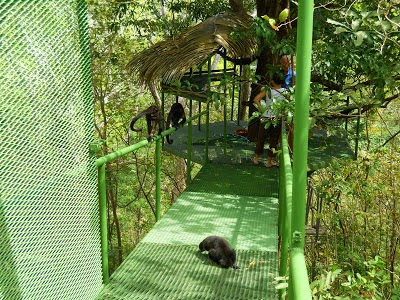The Sibu Sanctuary is a rescue and rehabilitation centre for
howler monkeys and other local wildlife that have been injured. It was started
by Vicki and Steve after they had moved to Nosara and found a baby injured
howler monkey. The baby’s mother had been electrocuted on an uninsulated power line
and the baby had fallen (Nosara has had a lot of development and the monkeys like to swing and run along the wires that look like vines from when there was more forest.) Many years later they have 50 acres of protected land
which includes a lot of forest and hills and bananas!! Also, they have a small
casita for volunteers to live in, their
own house, and the monkey enclosure right behind it.
The injured monkeys
first go to the Nosara Wildlife Rescue for medical care and then to the SIBU
Sanctuary where they are cared for until they are well enough and old enough to
be released back in the wildlife. Vicki
and Steve spend a lot of time talking and working with the government and power
company to get the wires insulated and try to get more money (for all the food
and supplies). But, most of their day is filled with taking care of the
monkeys.
On our visit, Steve met us at the front gate that has monkeys on them. We started a hike up to the sanctuary. Along the way, we met a worker
with a raccoon. The raccoon had been kept as a pet and couldn’t be released
back into the wild. Steve was telling us about the property, their history and
lots of things about the plants and trees. One of the trees, a pochote, has
spikes on its bark to keep the animals from climbing it and reaching the fruits.
He also told us that the indigenous people of Costa Rica thought when you died,
your soul would go through the roots and branches of this tree and be released.
We went to a lookout overlooking the hills and valleys and ocean. Then, we got
to ride in the back of his pick up truck up the house and sanctuary. We had to
duck down because one of the trees was leaning out over the road at eye level!
At the house, we got some juice from Vicki while she talked
about the sanctuary and all the animals who’d lived there. We also watched a
short film that a previous visitor had made. Then, we went down a walkway to
where the howler monkeys were kept. It was like one large enclosure with lots
of braches and tires and hammocks for the monkeys to climb and swing on. Some
of the hammocks had baby howlers peeking out at us from inside. There was a
large mat suspended about a metre off the ground and this is where the food
(mostly tender leaves and vegetables) is dumped. Steve fed them while we were
there and all the monkeys came running. One of the monkeys hung down from the
ceiling and tried to get on Patti’s head but she moved away just in time. We
weren’t allowed to touch them for safety reasons and Vicki and Steve want them
to remain as wild as possible. One of them peed on Mom’s t-shirt. We didn’t get
many photos because our memory card was filled up.
We also went to the enclosure that housed two white-faced
capuchin monkeys. There is a bigger door that when you slide it open it can connect
the two habitats. They have to make several locks because the monkeys are so
smart and mischievous and they can often figure out how to undo the locks! They
have a lot more energy than the howlers and were jumping around like toddlers.
They’ll eat anything, even baby birds.
Then, we entered a sort of treehouse that had coatis and a
Mexican Hairy Porcupine living in it. There were what looked like mini-bunkbeds
for them to sleep in. The porcupine looked cute but wasn’t what you’d call
friendly and tried to nip at Vicki’s hand. I think he just wanted a nap.
We asked many questions and kept wanting more stories so we
sort of went past the time we were supposed to be there. We had to hurry back.
After saying goodbye to Vicki we got a ride back down the hill, again watching
out for the tree. We also a green iguana just off the trail and a golden orb
spider weaving her web. When I get older, I think I’d like to stay there for a while
volunteering. Anyone who loves monkey and other wildlife should consider going
there and supporting the work. I’m keeping my eyes on the power lines and I
think I’ll write a letter to the power company and to the government to tell
them why I think the lines should be insulated.





No comments:
Post a Comment